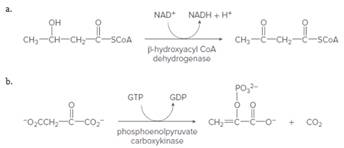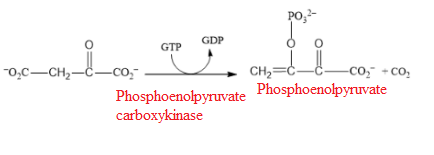
Concept explainers
Analyze each reaction by considering the 
(a)
Interpretation:
The given reaction catalyzed by beta-hydroxyacyl CoA dehydrogenase should be analyzed by taking consideration of the functional groups that can change reactant or coenzyme and name of enzyme.
Concept Introduction:
The catalysts which drives the rate of reaction are known as enzymes. Most of the catalyst are made up of proteins (chain of amino acids) which accelerate the rate of reactions in chemical system.
Answer to Problem 23P
The oxidation of β-hydroxy acyl CoA to form β -keto acyl CoA in the presence of an enzyme β-hydroxy acyl CoA dehydrogenase.
Explanation of Solution
The given reaction is represented as follows:

In the given reaction oxidation of β-hydroxy acyl CoA to form β -keto acyl CoA. In this reaction hydroxyl group changes to ketone group that means oxidation is taking place. The reaction is catalyzed by an enzyme known as β-hydroxy acyl CoA dehydrogenase which reduces NAD+ to NADH + H+. Hence, the reaction is said to be oxidation reaction.
(b)
Interpretation:
The given reaction catalyzed by phosphoenolpyruvate carboxykinase needs to be analyzed by taking consideration of the functional groups that can change reactant or coenzyme and name of enzyme.
Concept Introduction:
The catalysts which drives the rate of reaction are known as enzymes. Most of the catalyst are made up of proteins (chain of amino acids) which accelerate the rate of reactions in chemical system.
Answer to Problem 23P
The introduction of phosphate group is taking place with the help of Phosphoenolpyruvate enzyme.
Explanation of Solution
The reaction is represented as follows:

The reactant in the following above reaction is phosphorylating with GTP to produce phosphoenolpyruvate and GDP. Phosphoenolpyruvate (acts as an enzyme) catalyzes the reaction and removes carbon dioxide. And addition of phosphate group also takes place in the reaction.
Want to see more full solutions like this?
Chapter 24 Solutions
General, Organic, and Biological Chemistry - 4th edition
- 2. Please fill in missing reactants, reagents, reaction conditions, or products in the provided blank boxes OMe ...-CF2-CF2-CF2-CF2-CF2-...arrow_forwardDon't used hand raiting and don't used Ai solutionarrow_forwardI don't understand what to put for final step. Does that just mean termination? And would a radical form when I add bromine to ch2 between the rings?arrow_forward
 World of Chemistry, 3rd editionChemistryISBN:9781133109655Author:Steven S. Zumdahl, Susan L. Zumdahl, Donald J. DeCostePublisher:Brooks / Cole / Cengage Learning
World of Chemistry, 3rd editionChemistryISBN:9781133109655Author:Steven S. Zumdahl, Susan L. Zumdahl, Donald J. DeCostePublisher:Brooks / Cole / Cengage Learning World of ChemistryChemistryISBN:9780618562763Author:Steven S. ZumdahlPublisher:Houghton Mifflin College Div
World of ChemistryChemistryISBN:9780618562763Author:Steven S. ZumdahlPublisher:Houghton Mifflin College Div Chemistry for Today: General, Organic, and Bioche...ChemistryISBN:9781305960060Author:Spencer L. Seager, Michael R. Slabaugh, Maren S. HansenPublisher:Cengage Learning
Chemistry for Today: General, Organic, and Bioche...ChemistryISBN:9781305960060Author:Spencer L. Seager, Michael R. Slabaugh, Maren S. HansenPublisher:Cengage Learning General, Organic, and Biological ChemistryChemistryISBN:9781285853918Author:H. Stephen StokerPublisher:Cengage Learning
General, Organic, and Biological ChemistryChemistryISBN:9781285853918Author:H. Stephen StokerPublisher:Cengage Learning Organic And Biological ChemistryChemistryISBN:9781305081079Author:STOKER, H. Stephen (howard Stephen)Publisher:Cengage Learning,
Organic And Biological ChemistryChemistryISBN:9781305081079Author:STOKER, H. Stephen (howard Stephen)Publisher:Cengage Learning, Introductory Chemistry: An Active Learning Approa...ChemistryISBN:9781305079250Author:Mark S. Cracolice, Ed PetersPublisher:Cengage Learning
Introductory Chemistry: An Active Learning Approa...ChemistryISBN:9781305079250Author:Mark S. Cracolice, Ed PetersPublisher:Cengage Learning





